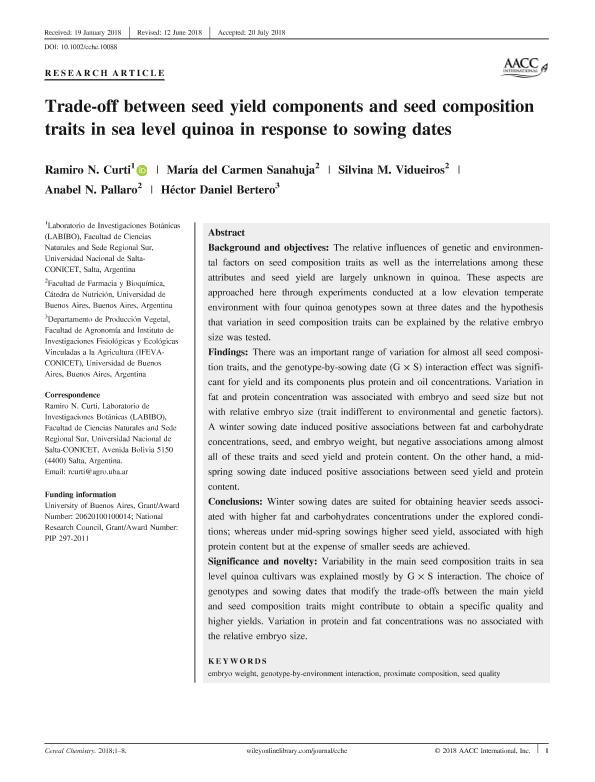Mostrar el registro sencillo del ítem
dc.contributor.author
Curti, Ramiro Nestor

dc.contributor.author
Sanahuja, María del Carmen

dc.contributor.author
Vidueiros, Silvina M.
dc.contributor.author
Pallaro, Anabel Nora

dc.contributor.author
Bertero, Hector Daniel

dc.date.available
2019-12-06T15:25:14Z
dc.date.issued
2018-09
dc.identifier.citation
Curti, Ramiro Nestor; Sanahuja, María del Carmen; Vidueiros, Silvina M.; Pallaro, Anabel Nora; Bertero, Hector Daniel; Trade-off between seed yield components and seed composition traits in sea level quinoa in response to sowing dates; Amer Assoc Cereal Chemists; Cereal Chemistry; 95; 5; 9-2018; 734-741
dc.identifier.issn
0009-0352
dc.identifier.uri
http://hdl.handle.net/11336/91618
dc.description.abstract
Background and objectives: The relative influences of genetic and environmental factors on seed composition traits as well as the interrelations among these attributes and seed yield are largely unknown in quinoa. These aspects are approached here through experiments conducted at a low elevation temperate environment with four quinoa genotypes sown at three dates and the hypothesis that variation in seed composition traits can be explained by the relative embryo size was tested. Findings: There was an important range of variation for almost all seed composition traits, and the genotype-by-sowing date (G × S) interaction effect was significant for yield and its components plus protein and oil concentrations. Variation in fat and protein concentration was associated with embryo and seed size but not with relative embryo size (trait indifferent to environmental and genetic factors). A winter sowing date induced positive associations between fat and carbohydrate concentrations, seed, and embryo weight, but negative associations among almost all of these traits and seed yield and protein content. On the other hand, a mid-spring sowing date induced positive associations between seed yield and protein content. Conclusions: Winter sowing dates are suited for obtaining heavier seeds associated with higher fat and carbohydrates concentrations under the explored conditions; whereas under mid-spring sowings higher seed yield, associated with high protein content but at the expense of smaller seeds are achieved. Significance and novelty: Variability in the main seed composition traits in sea level quinoa cultivars was explained mostly by G × S interaction. The choice of genotypes and sowing dates that modify the trade-offs between the main yield and seed composition traits might contribute to obtain a specific quality and higher yields. Variation in protein and fat concentrations was no associated with the relative embryo size.
dc.format
application/pdf
dc.language.iso
eng
dc.publisher
Amer Assoc Cereal Chemists

dc.rights
info:eu-repo/semantics/openAccess
dc.rights.uri
https://creativecommons.org/licenses/by-nc-sa/2.5/ar/
dc.subject
EMBRYO WEIGHT
dc.subject
GENOTYPE-BY-ENVIRONMENT INTERACTION
dc.subject
PROXIMATE COMPOSITION
dc.subject
SEED QUALITY
dc.subject.classification
Química Orgánica

dc.subject.classification
Ciencias Químicas

dc.subject.classification
CIENCIAS NATURALES Y EXACTAS

dc.title
Trade-off between seed yield components and seed composition traits in sea level quinoa in response to sowing dates
dc.type
info:eu-repo/semantics/article
dc.type
info:ar-repo/semantics/artículo
dc.type
info:eu-repo/semantics/publishedVersion
dc.date.updated
2019-10-23T21:09:57Z
dc.journal.volume
95
dc.journal.number
5
dc.journal.pagination
734-741
dc.journal.pais
Estados Unidos

dc.description.fil
Fil: Curti, Ramiro Nestor. Universidad Nacional de Salta. Facultad de Ciencias Naturales. Escuela de Agronomía. Laboratorio de Investigaciones Botánicas; Argentina. Consejo Nacional de Investigaciones Científicas y Técnicas; Argentina
dc.description.fil
Fil: Sanahuja, María del Carmen. Universidad de Buenos Aires. Facultad de Farmacia y Bioquímica; Argentina
dc.description.fil
Fil: Vidueiros, Silvina M.. Universidad de Buenos Aires. Facultad de Farmacia y Bioquímica; Argentina
dc.description.fil
Fil: Pallaro, Anabel Nora. Universidad de Buenos Aires. Facultad de Farmacia y Bioquímica; Argentina
dc.description.fil
Fil: Bertero, Hector Daniel. Consejo Nacional de Investigaciones Científicas y Técnicas. Oficina de Coordinación Administrativa Parque Centenario. Instituto de Investigaciones Fisiológicas y Ecológicas Vinculadas a la Agricultura. Universidad de Buenos Aires. Facultad de Agronomía. Instituto de Investigaciones Fisiológicas y Ecológicas Vinculadas a la Agricultura; Argentina
dc.journal.title
Cereal Chemistry

dc.relation.alternativeid
info:eu-repo/semantics/altIdentifier/url/https://onlinelibrary.wiley.com/doi/abs/10.1002/cche.10088
dc.relation.alternativeid
info:eu-repo/semantics/altIdentifier/doi/http://dx.doi.org/10.1002/cche.10088
Archivos asociados
